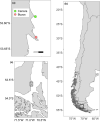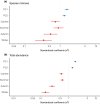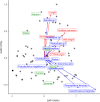Disentangling the links between habitat complexity and biodiversity in a kelp-dominated subantarctic community
- PMID: 33598125
- PMCID: PMC7863391
- DOI: 10.1002/ece3.7100
Disentangling the links between habitat complexity and biodiversity in a kelp-dominated subantarctic community
Abstract
Habitat complexity is one of the most important factors modulating species diversity. This feature comprises several interrelated attributes, such as number, size, and spatial arrangement of complexity-forming elements. However, the separate and joint effects of these attributes on diversity and community structure are still not well understood. Here, we assess the relationships between several structural-complexity attributes of the subantarctic kelp Lessonia flavicans and species richness, total abundance, and structure of kelp-associated macrobenthic communities. We predicted that longer thalli and larger holdfasts favor greater species richness and total abundance of invertebrate organisms. To test the prediction, an observational sampling program was established in two sites of the Strait of Magellan. Uni- and multivariate analyses revealed both positive and negative effects of kelp structural-complexity attributes on diversity. Holdfast diameter and maximum frond length, followed by thallus wet weight, had the strongest positive fits to species richness and total abundance; the number of stipes, on the other hand, was negatively associated with both response variables. Longer fronds were associated with greater abundances of spirorbid polychaetes. Larger holdfasts supported larger abundances of Nereididae and Terebelidae polychaetes and the limpet Nacella mytilina. Contrarily, kelps with longer fronds and more stipes supported fewer amphipods. In this way, we demonstrate that different dimensions of habitat complexity can have contrasting effects on diversity and community structure, highlighting the fundamental role of multiple dimensions of kelp habitat complexity for local biodiversity.
Keywords: Kelp forest; Patagonia; benthic communities; biodiversity; habitat complexity.
© 2021 The Authors. Ecology and Evolution published by John Wiley & Sons Ltd.
Conflict of interest statement
The authors declare that they have no conflict of interest.
Figures





References
-
- Aguayo, R. , León‐Muñoz, J. , Vargas‐Baecheler, J. , Montecinos, A. , Garreaud, R. , Urbina, M. , & Iriarte, J. L. (2019). The glass half‐empty: Climate change drives lower freshwater input in the coastal system of the Chilean Northern Patagonia. Climatic Change, 155(3), 417–435.
-
- Anderson, M. J. , & Willis, T. J. (2003). Canonical analysis of principal coordinates: A useful method of constrained ordination for ecology. Ecology, 84, 511–525.
-
- Arkema, K. , Reed, D. C. , & Schroeter, S. C. (2009). Direct and indirect effects of giant kelp determine benthic community structure and dynamics. Ecology, 90, 3126–3137. - PubMed
-
- Asensi, A. O. , & Küpper, F. C. (2012). Seasonal periodicity and reproduction of brown algae (Phaeophyceae) at Puerto Deseado (Patagonia). Botanica Marina, 55(3), 217–228.
-
- Barton, K. (2020). MuMIn: Multi‐Model Inference. R package version 1.43.17. Retrieved from https://CRAN.R‐project.org/package=MuMIn
Associated data
LinkOut - more resources
Full Text Sources
Other Literature Sources

